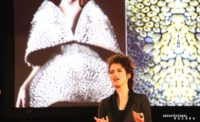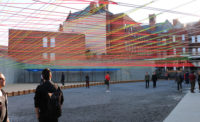If you want to get a sense for what’s next in ceramic tile innovation, the annual Cersaie exposition in Bologna, Italy is not an event to glaze over. The five-day international design bonanza, which wraps up today, features the latest in ceramic tiles, floor and wall coverings, and bathroom fixtures.
Now in its 34th edition, Cersaie (pronounced not like the Game of Thrones character, but “chur-SIGH”), draws nearly 900 exhibitors and upwards of 100,000 visitors to more than 38 acres of exhibition space. With such a turnout, several trends stood out.
Predictably, wood-inspired ceramic tiles made a strong showing. This year, however, they took the form of elaborate chevron and basket-weave designs in parquet. Textiles were another major force—from tiles mimicking tweed suiting, to those imprinted with lace. Italian company SICIS even developed a technique in which a mosaic effect is achieved by sealing a textile beneath glass. Technology also played an important roll this year. Ardogres, for instance, unveiled Ardosolar, a roof tile system that comes equipped with thin photovoltaic panels.
While many manufacturers looked to the future, others took inspiration from the past: Ceramica Francesco De Maio unveiled “Blu Ponti” which reproduces 12 boldly-patterned blue and white tiles designed by Giò Ponti. Meanwhile, Le Corbusier (whose reconstructed Pavilion de L’Esprit Nouveau sits alongside the BolognaFiere convention center) is part of an exclusive collection for Gigacer. The manufacturer is recreating the tiles in a dozen of the 63 colors Le Corbusier deemed suitable for architecture. For their Cersaie display, Gigacer even replicated the brise-soleil of his Maison de la Culture in Firminy, France with the new product.
The conference’s keynote speaker, Norman Foster, also spoke of le Corbusier’s influence—especially the parallels he drew in between architecture and machinery. “I find [those connections] inseparable from my interest in buildings and design,” Foster said. “It’s one seamless link.”
The Pritzker prize-winning architect went on to discuss buildings that influenced his career—from the the Palm house at the Royal Botanic Gardens in London to Albert Kahn’s Goodyear Airdock in Akron, Ohio—and current work, including the ring-shaped Apple campus in Cupertino, California and a prototype for a humanitarian droneport in Africa.
Foster concluded his address with an anecdote from the Scopus Awards, an honor bestowed by the Friends of the Hebrew University. The performance artist Marina Abramović designed an unusual award for Foster—a golden model of the architect’s brain, as well as a bizarre pink, cerebrum-like cap Abramović christened a “brain cozy.”
“If I try to find a moral behind this, I’d say that in the pursuit of architecture and beauty, it’s all about the creative power of the individuals, the teams—it’s never about the amount of funds,” said Foster. “It’s totally about the creative part.”












Post a comment to this article
Report Abusive Comment